We hope the information below is informative and helpful to parents of young dreamers and achievers!
As parents, we raised our sons to be respectful and humble above all. Education was primary because no matter what their other activities were, education and knowledge build confidence and help develop character. We knew they could always fall back on their education if their athletic pursuits or other talents and interests became secondary in their lives. Beyond education, to help them achieve their maximum potential athletically, musically, artistically or whatever their chosen passion is, there are some critical points we followed.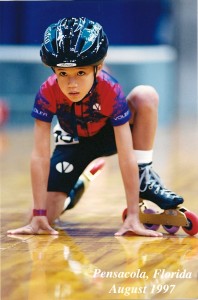
First, a child must love to do his or her desired activity. We, as parents encouraged our sons and exposed them to many different activities. They determined what their true passion was. For J.R., it happened to be speedskating though he also played soccer and inline hockey for several years. Chris and David both skated inline in their young years, but moved on to other activities and sports when they were ready. We always encouraged them in their new ventures.
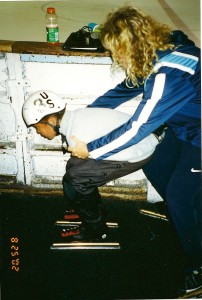 Second, it is critical that they learn the technique of their activity – in detail – as early as possible. For J.R. – rather than going “fast” at an certain age, we focused on the technique of speedskating. What is it that propels one athlete past another in a seemingly effortless way? That is technique. It takes a long time to develop the proper technique in any activity, but getting it down is what separates the athletes later down the road. Great coaches – like J.R.’s coach Wilma Boomstra – shown working with J.R. at left in his first ice lesson – are essential in this part.
Second, it is critical that they learn the technique of their activity – in detail – as early as possible. For J.R. – rather than going “fast” at an certain age, we focused on the technique of speedskating. What is it that propels one athlete past another in a seemingly effortless way? That is technique. It takes a long time to develop the proper technique in any activity, but getting it down is what separates the athletes later down the road. Great coaches – like J.R.’s coach Wilma Boomstra – shown working with J.R. at left in his first ice lesson – are essential in this part.
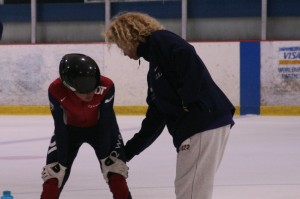
Third, the athlete / student must listen to their coaches and mentors. They can not act as a know-it-all. Their task is to learn continuously. Even all-time greats like Nolan Ryan studied his sport and learned up until the day he retired. Take critical comments from the experts with grace – they are doing you a favor by taking time to help you out.
As J.R. rose to world class, it became evident to us that there was something separating athletes from one another at that level. World class performers generally have the same coach, trainers, facilities, equipment, food, and even desire. Aside from these factors, often times what distinguishes one from the other is the fuel they put in their bodies.
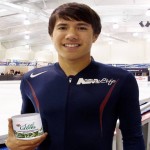 The higher the quality of the fuel, the better the performance. This includes bioavailable nutrition in the form of supplements that help replenish the essential vitamins and minerals, feeding the body with plant based enzymes, and proteins / amino acids. It means keeping the cell walls fluid, allowing for rapid entry of energy into the cells and removal of undesireable substances like toxins and lactic acid from the cells. Essential to the athlete is consuming the right fuel for energy, working at the cellular level to allow rapid recovery of the body between games, practices, or even between drills during the same practice. For example, soccer or baseball players competing in a long weekend tournament with two matches a day for three days. Proper hydration and nutritional supplementation for recovery is critical for continuous energy and high level performance.
The higher the quality of the fuel, the better the performance. This includes bioavailable nutrition in the form of supplements that help replenish the essential vitamins and minerals, feeding the body with plant based enzymes, and proteins / amino acids. It means keeping the cell walls fluid, allowing for rapid entry of energy into the cells and removal of undesireable substances like toxins and lactic acid from the cells. Essential to the athlete is consuming the right fuel for energy, working at the cellular level to allow rapid recovery of the body between games, practices, or even between drills during the same practice. For example, soccer or baseball players competing in a long weekend tournament with two matches a day for three days. Proper hydration and nutritional supplementation for recovery is critical for continuous energy and high level performance.
Elite athletes with intense workouts release high levels of free radicals into the body. Potent antioxidents are required by these athletes to neutralize the free radicals and normalize the body. Reducing inflammation is critical as well, as the muscles working overtime become sore and tired.
Immune system protection through the use of supplementation is essential. An athlete who is sick with colds or other illnesses is missing training time, or rendered less effective during training. A strong immune system will prevent illness and the athlete can attend the training, and be fully effective and responsive.
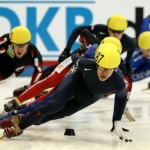
Digestive health is no less important. An athlete whose digestive system is working properly can transfer food into energy quicker and more thoroughly, and rid of the residual waste products quicker. Carrying less waste in the colon is not only more healthy, it is less weight laying in the colon to slow the athlete down. Even less than a pound of waste during a two hour practice or competition means a lot of extra effort and energy spent compared to it not being there.
During his entire short track speedskating career, J.R. was on a full regimen of nutritional supplements by The AIM Companies. His product list included AIM BarleyLife (the flagship product), AIM Herbal Fiberblend, AIMega, AIM Proancynol 2000, AIM Peak Endurance, CalciAIM, AIM Cellsparc 360, and AIM Leaf Greens. These supplements provided him the nutritional advantage to take care of all the challenges discussed above, and much more.
An athlete doesn’t have to start with the full regimen that J.R. was on. Even he didn’t take all these products to start. For younger athletes or athletes beginning a new sport, we recommend starting out with the basics: AIM BarleyLife, AIM Herbal Fiberblend, AIMega, and AIM Peak Endurance. These cover all the basic needs of an athlete. The other products can be added on as the athlete advances in the sport to where he or she needs a higher level of nutritional advantage. If you would like your son or daughter to gain these same advantages – whether they are just starting out or advanced to higher levels – please contact us and we will gladly discuss how they can follow J.R.’s regimen to better performance and superior overall health.
And AIM nutrition is not just for athletes! Even non-athletes can benefit greatly from the AIM regimen for better immune system, digestive system, cardio system, and improved health of other body systems.
Please feel free to send us a message on the Contact link, or call us at any time. We are here to help you and your young performers in any way.
Be sure to check out J.R.’s Healing Story link for more on how J.R. rose to the top of the short track speedskating world at such a young age, despite the near life-ending injury he suffered in September 2009.